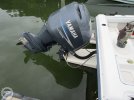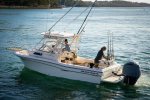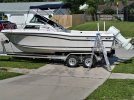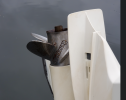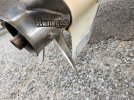Hi Grady Folks,
I've taken a great deal of wisdom from the online community over the past year, and to pay it back I'd like to post some observations about my 226 after a full season of use. Hopefully someone who's in the used WA market finds this to be a helpful resource, whether now or down the road.
Some quick context- I bought the boat in March 2021 from a private owner in south NJ and brought it up to its new home port on the LI Sound in Connecticut the following month (a memorable 6+ hour boat ride). The boat had been repowered by the original owner in 2013 with an ETEC 200HO. It is a SeaV2 hull and has the factory hardtop. I get the sense that it was maintained very well from 1994 through the repower, then perhaps a bit less thereafter as the original owner's health declined. As for me, I've been on and around boats with family most of my life on the coast in NJ, most notably on an old Boston Whaler 17' Outrage, BW 205 Eastport (a WA model built for one year in 2005), and a 23 Regulator. This however is the first boat I've owned myself as well as the first Grady I have extensive experience with.
Over the course of the 2021 season I've put about 50 hours on the engine, comprised mostly of local fishing trips with my wife and some slightly longer voyages to dockages in Long Island. The LI sound, I've learned, doesn't often have the heavy swells you find in the ocean, but makes up for it with plenty of short period chop especially in wind-against-tide conditions.
Without further delay, the observations:
- Ride: Like most Gradys, the 226 is not a heavy, deep V offshore wave slicer like a Regulator. It's more of a multipurpose hull design intended to be seaworthy in varied sea states as well as efficient and quick planing. I've found these generalizations to hold true. My boat doesn't have trim tabs but is extremely responsive to engine trim, so the running attitude can be adjusted for the sea conditions easily and with great effect. In a head sea with the engine trimmed all the way in, it runs well if you can keep the sea pretty much straight on the nose. It can pound a bit if you take the wrong quartering angle and let the waves smack the flatter sections of the bow but this is pretty easy to avoid. In a following sea, the boat responds well to trimming the engine out and letting the nice burly flared bow and lifting strakes keep the nose up. There's a sweet spot of trim somewhere around 1/4th of the way up that seems to do the trick in most mild or confused wave conditions. All in all, if you keep your expectations reasonable and pay a bit of attention to how you operate the boat, it's a solid and comfortable platform even for occasional longer runs.
- Engine & Performance: Ahh, the much-embattled ETEC G1. First thing's first, we've lost exactly 0 days of boating to engine issues in year 1, so on the most important criteria the engine has been flawless so far. Never stalled, always starts up with one turn. The 200HO is basically a de-tuned v6 225 that has been shown to produce something in the range of 218 hp which is ample for the boat. Perhaps a perfect match would be something like a V6 225 Mercury 4 stroke, but this package gets the boat into the low 40s under a normal load which is plenty for my applications. It also has a noticeably strong grunt at low RPMs which helps with close quarters maneuvering and jumping out of the hole. The big downside of the 2-stroke to me is the noise, especially insofar as it makes the stern seating unpleasant when underway. This engine is heavy for a 2-stroke at 510 lbs. I wouldn't want to go heavier since the boat sits with the external scupper drains about half submerged, but I've never had an issue with water on the deck so I don't see it as a negative. Finally, we run a 4-blade prop. Unfortunately I don't know the prop details but I assume it's partially responsible for the overall strong performance of the boat.
- Layout & Design: The 226 offers a spacious fishing deck for its size. The downside of that is it puts the helm very far forward which can be a negative for the ride quality. Access to the bow isn't bad, probably about average for this class of boat. It would be great if the cabin could fit 7' fishing rods in the designated rod holders but they only fit diagonally. Another small gripe is that the helm doesn't leave a very natural place for an electronics unit of any size and the overhead electronic box is a little in the way. But other than those fairly minor complaints, I find the layout to be functional and well suited for our primary uses.
- Durability: This is a little hard to address since it's largely a function of maintenance, but overall the boat inspires alot of confidence for a vehicle approaching 30 years old. The big liability with these of course is the transom which is original on this boat. It does show some surface damage to the gelcoat around the engine bolts, but I've addressed this and it hasn't grown worse throughout the year. Otherwise it feels strong and solid, so I'm optimistic that I can get some more years out of it. One part that hasn't held up so well is the wiring. Pretty much all non-essential electrical components (and, at times, the VHF) are non-functional at this point, but could undoubtedly be brought back to life. The only major work I've had done since taking ownership was having it hauled to replace the thru-hull drain fittings, some of which were looking ready to let go. All in all, the boat is as mostly as capable as it was when it was new, which I think speaks well for its build quality and durability.
- The Bracket Question: I realize this is a subject that inspires great passion on both sides in Grady circles. I targeted a non-bracket Seafarer for the improved maneuverability and shorter LOA for docking. I haven't had any issues with water entering over the transom, but I realize others may use their boat in ways that make this more of a concern. Here's one unpopular opinion that I'm pretty convinced about: I think the lack of a bracket actually INCREASES fishability out of the stern because you can fish over the engine in a limited capacity, whereas the bracket pushes the engine far enough out that this is harder. That said, I don't like the design of the flip-up transom piece, which could be just about blown down with a stiff breeze. I'd much prefer this could be locked in place and am planning to modify it with hooks.
All in all, year 1 has been a great success and I’m extremely pleased with how the boat purchase worked out. Sure it would be great to have a bit more LOA for longer runs and a bit more creature comforts in the cabin, but for the majority of our needs the boat has proven to be just the ticket.
I've taken a great deal of wisdom from the online community over the past year, and to pay it back I'd like to post some observations about my 226 after a full season of use. Hopefully someone who's in the used WA market finds this to be a helpful resource, whether now or down the road.
Some quick context- I bought the boat in March 2021 from a private owner in south NJ and brought it up to its new home port on the LI Sound in Connecticut the following month (a memorable 6+ hour boat ride). The boat had been repowered by the original owner in 2013 with an ETEC 200HO. It is a SeaV2 hull and has the factory hardtop. I get the sense that it was maintained very well from 1994 through the repower, then perhaps a bit less thereafter as the original owner's health declined. As for me, I've been on and around boats with family most of my life on the coast in NJ, most notably on an old Boston Whaler 17' Outrage, BW 205 Eastport (a WA model built for one year in 2005), and a 23 Regulator. This however is the first boat I've owned myself as well as the first Grady I have extensive experience with.
Over the course of the 2021 season I've put about 50 hours on the engine, comprised mostly of local fishing trips with my wife and some slightly longer voyages to dockages in Long Island. The LI sound, I've learned, doesn't often have the heavy swells you find in the ocean, but makes up for it with plenty of short period chop especially in wind-against-tide conditions.
Without further delay, the observations:
- Ride: Like most Gradys, the 226 is not a heavy, deep V offshore wave slicer like a Regulator. It's more of a multipurpose hull design intended to be seaworthy in varied sea states as well as efficient and quick planing. I've found these generalizations to hold true. My boat doesn't have trim tabs but is extremely responsive to engine trim, so the running attitude can be adjusted for the sea conditions easily and with great effect. In a head sea with the engine trimmed all the way in, it runs well if you can keep the sea pretty much straight on the nose. It can pound a bit if you take the wrong quartering angle and let the waves smack the flatter sections of the bow but this is pretty easy to avoid. In a following sea, the boat responds well to trimming the engine out and letting the nice burly flared bow and lifting strakes keep the nose up. There's a sweet spot of trim somewhere around 1/4th of the way up that seems to do the trick in most mild or confused wave conditions. All in all, if you keep your expectations reasonable and pay a bit of attention to how you operate the boat, it's a solid and comfortable platform even for occasional longer runs.
- Engine & Performance: Ahh, the much-embattled ETEC G1. First thing's first, we've lost exactly 0 days of boating to engine issues in year 1, so on the most important criteria the engine has been flawless so far. Never stalled, always starts up with one turn. The 200HO is basically a de-tuned v6 225 that has been shown to produce something in the range of 218 hp which is ample for the boat. Perhaps a perfect match would be something like a V6 225 Mercury 4 stroke, but this package gets the boat into the low 40s under a normal load which is plenty for my applications. It also has a noticeably strong grunt at low RPMs which helps with close quarters maneuvering and jumping out of the hole. The big downside of the 2-stroke to me is the noise, especially insofar as it makes the stern seating unpleasant when underway. This engine is heavy for a 2-stroke at 510 lbs. I wouldn't want to go heavier since the boat sits with the external scupper drains about half submerged, but I've never had an issue with water on the deck so I don't see it as a negative. Finally, we run a 4-blade prop. Unfortunately I don't know the prop details but I assume it's partially responsible for the overall strong performance of the boat.
- Layout & Design: The 226 offers a spacious fishing deck for its size. The downside of that is it puts the helm very far forward which can be a negative for the ride quality. Access to the bow isn't bad, probably about average for this class of boat. It would be great if the cabin could fit 7' fishing rods in the designated rod holders but they only fit diagonally. Another small gripe is that the helm doesn't leave a very natural place for an electronics unit of any size and the overhead electronic box is a little in the way. But other than those fairly minor complaints, I find the layout to be functional and well suited for our primary uses.
- Durability: This is a little hard to address since it's largely a function of maintenance, but overall the boat inspires alot of confidence for a vehicle approaching 30 years old. The big liability with these of course is the transom which is original on this boat. It does show some surface damage to the gelcoat around the engine bolts, but I've addressed this and it hasn't grown worse throughout the year. Otherwise it feels strong and solid, so I'm optimistic that I can get some more years out of it. One part that hasn't held up so well is the wiring. Pretty much all non-essential electrical components (and, at times, the VHF) are non-functional at this point, but could undoubtedly be brought back to life. The only major work I've had done since taking ownership was having it hauled to replace the thru-hull drain fittings, some of which were looking ready to let go. All in all, the boat is as mostly as capable as it was when it was new, which I think speaks well for its build quality and durability.
- The Bracket Question: I realize this is a subject that inspires great passion on both sides in Grady circles. I targeted a non-bracket Seafarer for the improved maneuverability and shorter LOA for docking. I haven't had any issues with water entering over the transom, but I realize others may use their boat in ways that make this more of a concern. Here's one unpopular opinion that I'm pretty convinced about: I think the lack of a bracket actually INCREASES fishability out of the stern because you can fish over the engine in a limited capacity, whereas the bracket pushes the engine far enough out that this is harder. That said, I don't like the design of the flip-up transom piece, which could be just about blown down with a stiff breeze. I'd much prefer this could be locked in place and am planning to modify it with hooks.
All in all, year 1 has been a great success and I’m extremely pleased with how the boat purchase worked out. Sure it would be great to have a bit more LOA for longer runs and a bit more creature comforts in the cabin, but for the majority of our needs the boat has proven to be just the ticket.




